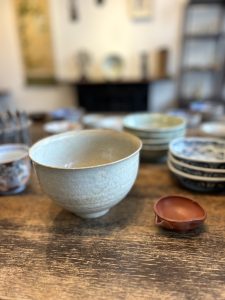雑器の美しさ(愛知県名古屋市千種区姫池通 骨董買取 古美術風光舎)
2023.12.23
みなさまこんにちは、スタッフHでございます。
今朝はすっかり雪景色となった地域もあり、冷え込む朝となりました。寒い日は温かい麺類などを食べて体の芯から温まりたい欲求にかられます。
こちらの器はうどんなどにうってつけだなぁなどと眺めておりました。李朝の雑器になります。
ふくよかな丸みが優しく手に馴染みます。小さめの高台ですが上手くバランスをとれていて安定感を感じます。胡麻和えなども合いそうです。

李朝の器という言葉はよく聞くのですが、曖昧な知識でしたので少し調べてみました。
李朝とは李氏朝鮮時代を意味し、1392年~1897年にかけて約500年もの間続いた朝鮮半島の王朝です。この時代、名もなき職人によって木工品、金工品など暮らしに寄り添う数々の優れた道具が作られ、のちに李朝工芸と呼ばれるようになります。なかでも陶磁器は李朝工芸の代表ともいわれ、三島手、粉引、刷毛目、そして白磁などが今も愛されています。
白磁焼成は広州窯、道馬里、金少里、分院などの官窯で作られた名品だけではなく、地方においても味わい深い焼き物を生み出しました。
韓国の伝統的な技術は、家族や血縁者に継承されることも多く、特に工芸品は観賞用ではなく実用性を重んじるため、不均衡で精巧さに欠ける面もありますが、その自然で素朴な味わいに美しさを感じ、魅了される人が多くいます。
直前の高麗王朝では仏教が中心でしたが、李氏朝鮮では儒教を社会の基盤としました。中国の孔子による古典的な儒教とは違い、より厳しい教えだったといわれています。中国南宋の儒学者である朱熹(しゅき)が更に奥深く探求し体系化した「朱子学」が朝鮮王朝の統治理念となりました。高麗末期の動乱期に導入され、複雑で厳しい教えだそうです。
質素倹約を美徳とし、王に対する忠誠や親に対する孝行などを生活の指針としていました。
白磁の白は儒教の教えである「清廉潔白」を象徴し、「清貧の美」を表す色とされています。
李朝工芸のコレクターには日本人も多いとか。そのきっかけを作った人物が1910年代ソウルに渡った日本人教師、浅川伯教だと言われています。夜も更けたソウルの街でふと立ち寄った古道具屋で白い丸壷に出会い強く心惹かれ、李朝工芸を収集し始めます。帰国の折には柳宗悦氏(やなぎむねよし)への手土産として「秋草紋染付面取壺」と呼ばれる白磁の壺を持参し、この偶然の出会いが柳氏を民芸の道へつき動かすきっかけになったとされています。
柳氏は「雑器の美」という著書の中で、「雑器の美は無心の美である。」と綴っています。毎日使うために頑丈でなければいけない。機能性、使いやすい形、色などに自然となっているからこそ、そこから美が醸し出されるとのこと。
私などは審美眼がその域にまで達しておらず、こちらの李朝の器を眺めていると食べ物が浮かんできてお腹が空いてまいります。もっと精進いたします。
それでは、またお会いしましょう。

Hello everyone, this is Staff H.
It was a chilly morning with snow in some areas this morning. On a cold day, I have a craving for warm noodles to warm up my body from the core.
I was looking at this bowl, which is perfect for udon noodles. It is a Yi Dynasty dish.
The roundness of the bowl is soft and comfortable in the hand. It has a small base, but it is well balanced and stable. It would be suitable for serving with sesame paste.
I have often heard the term “Yi Dynasty” but my knowledge of the term was vague, so I did a little research.
Yi Dynasty means the Yi Dynasty of Korea, a dynasty on the Korean peninsula that lasted for about 500 years from 1392 to 1897. During this period, nameless craftsmen produced a number of excellent tools for daily life, including woodwork and metalwork, which later came to be known as Yi Dynasty crafts. Among them, ceramics are said to be the representative of Yi Dynasty crafts, and Mishimategate, kohiki, hakeme (brushwork), and white porcelain are still loved to this day.
White porcelain firing was not limited to masterpieces made at the official kilns of Gwangju, Doma-ri, Geumsa-ri, and Bunwon.
Traditional Korean techniques are often passed on to family members or blood relatives, and because crafts, in particular, are valued for their practicality rather than their ornamental value, they can be unbalanced and less elaborate in some respects, but many people are fascinated by the beauty of their natural and simple flavors.
While Buddhism was the main religion of the immediately preceding Goryeo Dynasty, Confucianism was the foundation of society in Yi Dynasty Korea. Unlike the classical Confucianism of Confucius in China, it is said that Confucianism was a more strict teaching. The Confucian scholar Zhu Xi of China’s Southern Song Dynasty explored and systematized the teachings in greater depth, and “Zhu Xi Gak” became the governing philosophy of the Joseon Dynasty. It was introduced during the period of upheaval at the end of the Goryeo Dynasty and is said to be a complex and strict teaching.
Frugality and thrift were regarded as virtues, and loyalty to the king and filial piety to one’s parents were the guiding principles of life.
The white color of white porcelain symbolizes the Confucian teaching of “purity and innocence,” and is said to represent the beauty of poverty.
Many collectors of Yi Dynasty crafts are Japanese. It is said that the person who started this trend was Asakawa Hakkyo, a Japanese teacher who came to Seoul in the 1910s. In the late evening in Seoul, he stopped by an antique store and was fascinated by a white round jar, and began to collect Yi Dynasty crafts. When he returned to Japan, he brought a white porcelain jar called a “chamotori jar with an autumn grass pattern” as a gift for Yanagi Muneyoshi, and this chance encounter is said to have been the catalyst that propelled Yanagi to pursue a career in folk art.
In his book, “The Beauty of Miscellaneous Vessels,” Yanagi wrote, “The beauty of miscellaneous vessels is the beauty of the mindless. The beauty of a piece of furniture must be sturdy enough to be used every day. It must be sturdy for daily use. It must be functional, and its shape and color must be easy to use, so that beauty can be created from it.
I, for one, have not yet reached that level of aesthetics, and when I look at this Yi Chao ware, food comes to mind and I get hungry. I will be more diligent.
I hope to see you again.
*******************
ご実家の整理やお片付けなどをされている方のご相談などが多くございます。
寒さ厳しい季節ですので、お片付けなどくれぐれもご無理のないようになさってくださいませ。
風光舎では古美術品や骨董品の他にも絵画や宝石、趣味のお品など様々なジャンルのものを買受しております。
お片付けをされていて、こういうものでもいいのかしらと迷われているものでも、どうぞお気軽にご相談下さいませ。
また風光舎は、出張買取も強化しております。ご近所はもちろん、愛知県内、岐阜県、三重県その他の県へも出張いたします。
まずは、お電話お待ちしております。
愛知県名古屋市千種区姫池通
骨董 買取
【古美術 風光舎 名古屋店】
TEL052(734)8444
10:00-17:00 OPEN
#出張買取#骨董#古美術#骨董品#絵画#版画#茶道具#刀剣#彫刻

